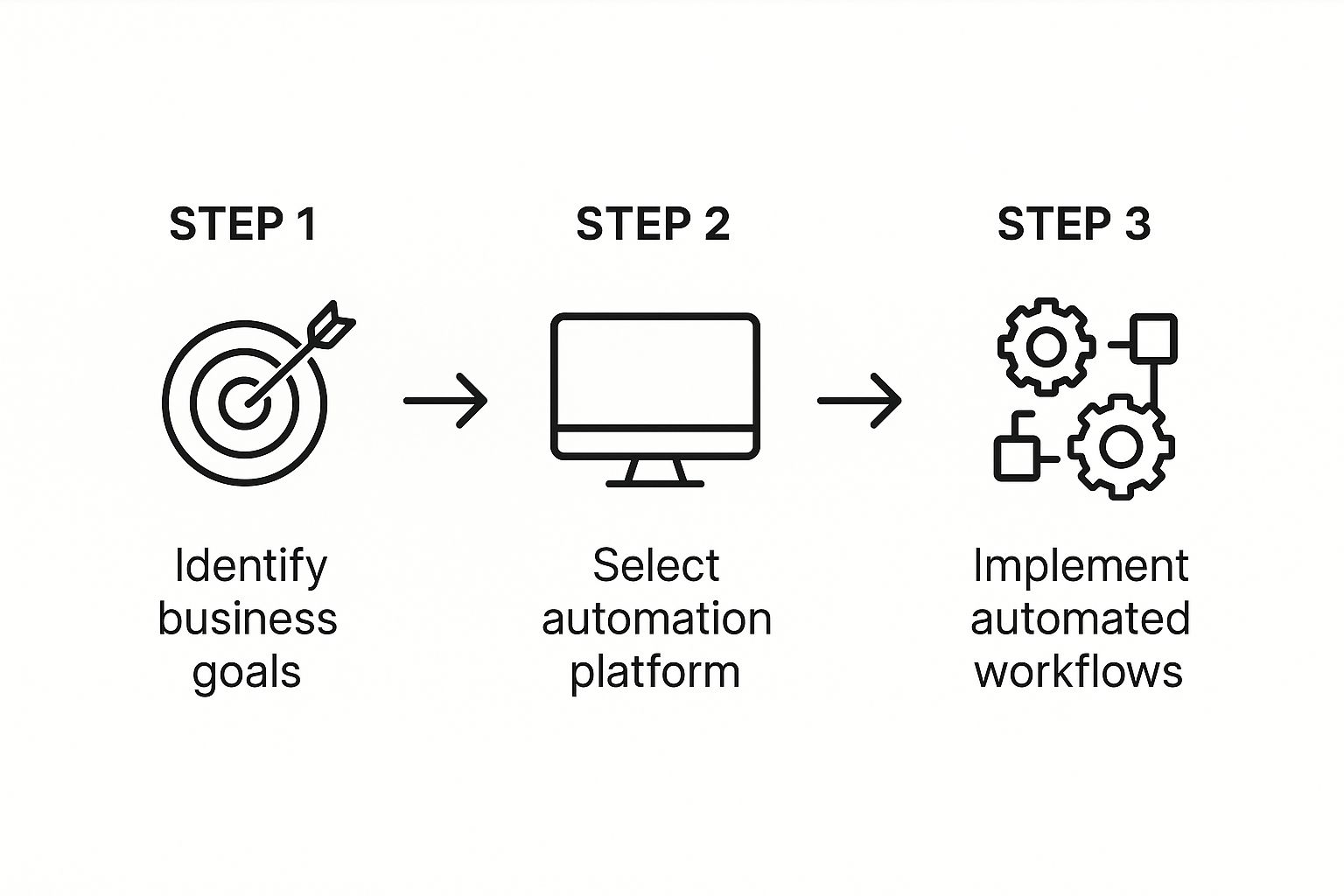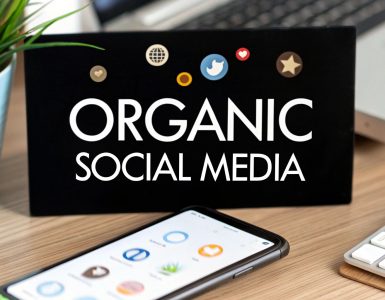When you hear "marketing automation," it's easy to picture a complex, impersonal system fit for a massive corporation. But for a small business, it's something much more practical. It's about using smart software to handle the repetitive, time-consuming marketing chores—like sending welcome emails or scheduling social media posts—so you can get back to actually growing your business.
Think of it less as "robotic" and more as being incredibly efficient and consistent. It frees you up from the manual grind.
Your Secret Weapon for Growth
Let's be real. As a small business owner, you're the CEO, head of marketing, lead salesperson, and the entire customer service department. It's a constant juggling act, and strategic, long-term marketing can feel like a luxury you just don't have time for.
This is exactly where marketing automation comes in. It's not here to replace your genuine, human touch. It’s here to amplify it. It works around the clock as your tireless digital assistant, nurturing leads, engaging customers, and making sure your brand stays visible, even when you're focused on other things. By taking over the predictable tasks, it lets you pour your energy into what you do best: building relationships, innovating, and steering the ship.
Leveling the Playing Field
Not long ago, running sophisticated, multi-touch marketing campaigns was a game reserved for companies with huge teams and even bigger budgets. Today, automation changes everything. It gives you the power to execute professional, targeted campaigns that would be a logistical nightmare to manage by hand.
For instance, you can automatically:
- Welcome new subscribers with a friendly, personalized email series.
- Gently nudge customers about items they left in their shopping cart.
- Plan and schedule an entire month of social media content in a single afternoon.
- Segment your audience to send special offers that actually feel relevant to them.
This is about more than just saving a few hours. It’s about creating a more polished and responsive experience for your customers. That kind of consistent, thoughtful communication builds real trust and keeps your brand top-of-mind, which is the magic ingredient for turning a one-time buyer into a lifelong fan. If you want to dig deeper into the core strategies and benefits, this complete guide to marketing automation for small businesses is a fantastic resource.
The big idea is simple: Automate the predictable so you can personalize the exceptional. You focus on the strategy and creative spark; the software handles the repetitive legwork.
There's a reason these tools are catching on so quickly. The global marketing automation market was valued at an impressive $5.65 billion in 2024 and is expected to soar to $14.55 billion by 2031. What’s driving this incredible growth? More than 400 million small businesses across the globe are discovering how automation can completely reshape their operations.
To get started, it helps to see where automation can make the biggest difference.
Here are the marketing functions that benefit most from automation, along with their key advantages for a small business.
Core Automation Areas for Small Business Impact
| Automation Area | Primary Benefit | Example Task |
|---|---|---|
| Email Marketing | Nurtures leads and builds relationships over time, on autopilot. | Sending a 3-part welcome email series to new subscribers. |
| Social Media | Maintains a consistent brand presence without daily manual posting. | Scheduling a month of posts across Facebook and Instagram. |
| Lead Generation | Captures and segments new contacts automatically. | A pop-up form that adds new leads to a specific email list. |
| Customer Journey | Creates a personalized experience based on user actions. | Triggering a follow-up email after a customer makes a purchase. |
| Reporting & Analytics | Provides clear data on what's working and what isn't. | Generating a weekly report on email open rates and clicks. |
By focusing on these key areas first, you can get the most significant return on your time and investment, building a solid foundation for more advanced strategies down the road.
How to Choose the Right Automation Platform

Picking the right small business marketing automation tool can feel overwhelming. You’re faced with a sea of options, and every single one claims to be the best. Here’s a secret: the “best” platform is simply the one that fits your specific needs, budget, and way of working.
It’s easy to get distracted by flashy features you'll probably never touch. A much better approach is to start with a clear picture of where you are right now. What marketing tasks are eating up most of your time? Your first goal is to find a platform that solves those immediate headaches.
Define Your Core Needs
Before you even glance at a pricing page, you need to know exactly what you’re shopping for. Are you drowning in manual email follow-ups? Is keeping your social media channels active the biggest drain on your resources? Get brutally honest about your primary pain points.
I always recommend creating a simple checklist of "must-haves" versus "nice-to-haves." This list will become your compass.
-
Must-Haves: These are your non-negotiables. For a local bakery, this might be a simple email tool to send out weekly specials and a basic landing page builder for holiday pre-orders. Without these, the tool is a no-go.
-
Nice-to-Haves: These are features you could see yourself using down the road, but they aren't critical today. That same bakery might see advanced lead scoring as a "nice-to-have" for the future, but it’s not essential for getting started.
This simple exercise keeps you from overpaying for a complex system when a more focused, affordable tool would do the job perfectly. You want to solve today's problems while leaving the door open for tomorrow's growth.
Evaluate Usability and Support
A powerful tool is completely useless if you can't figure out how to use it. I've seen too many small businesses invest in a platform with a steep learning curve, only to abandon it a few months later out of pure frustration. Look for tools that feel intuitive, ideally with a drag-and-drop interface.
My biggest piece of advice for small teams is to never underestimate the value of great customer support. When you’re stuck on a technical issue at 4 PM on a Friday, quick and helpful support is worth its weight in gold.
Most platforms offer a free trial, and you should absolutely use it. Don't just poke around the dashboard. Try to build a real, simple workflow—like a three-part welcome email series for new subscribers. This hands-on test is the fastest way to see how user-friendly the software truly is.
Consider Scalability and Budget
Your business isn't going to stay the same size forever, and your automation platform should be ready to grow with you. A common trap for small businesses is picking a tool that seems cheap at first but becomes incredibly expensive as your contact list expands.
When you're comparing pricing, look beyond the shiny entry-level plan. Ask yourself a few key questions:
- How much will this cost when I have 5,000 contacts instead of 500?
- Are crucial features like A/B testing or multi-step workflows locked away in a pricey upper tier?
- Does it play nice with the other tools I already rely on, like my e-commerce platform or website builder?
Choosing a scalable solution from the start saves you from a massive headache down the line. You won't have to deal with a complicated and costly migration to a new platform right when your business is hitting its stride. The right small business marketing automation tool should empower you from day one and support your journey for years to come.
Let's Build Your First Automated Welcome Series
Alright, enough with the theory. It's time to get your hands dirty and build something that works. If there's one piece of small business marketing automation you absolutely must set up, it's a welcome email series. Why? Because it’s your first, best chance to make a great impression the moment someone shows interest. It’s like having a friendly employee greet every new person who walks into your shop, even while you’re busy with a dozen other things.
We're not going to overcomplicate this. Forget those massive, 20-step email sequences you might have seen. We're aiming for a simple, powerful series that makes your new contacts feel seen and valued from day one. When someone gives you their email address, they're showing a level of trust. A prompt, personal welcome is how you honor that trust and start building a real relationship.
Laying the Groundwork for Your Welcome Flow
Before you can send any emails, you need a system to catch your new subscribers. Think of it as setting up a digital reception desk.
Inside your email marketing or automation platform (like Mailchimp or Brevo), the first thing you'll do is create a specific list, group, or tag just for these new sign-ups. For example, you might name it "New Newsletter Subscribers." Then, you'll connect this to your sign-up form. Now, whenever someone fills out that form, they're automatically added to this list. That action becomes the trigger that kicks off your entire welcome series.
Once that trigger is in place, you’ll build out the actual workflow—a visual map of what email sends when. A simple 3-part series is the perfect place to start. As the infographic shows, putting the workflow together is the final step after you've figured out your goals and picked your tools.

Now, let's get into what you'll actually put inside those emails.
Crafting Your 3-Part Email Sequence
Every email in your welcome series needs a job to do. You're not just blasting out messages; you're guiding a new friend on a journey. Here’s a tried-and-true formula I’ve seen work wonders for countless small businesses.
Email 1: The Warm Welcome & The Goods (Send Immediately)
This first email has one critical task: deliver on your promise. Did they sign up for a 10% discount? A free PDF guide? Give it to them right away, no strings attached.
Keep this email short, genuinely friendly, and focused on showing gratitude. A little personalization goes a long way here; using their first name makes it feel less robotic. A subject line like, "You're in! Here's your guide, {{first_name}}" is a great start.
Email 2: Your Story & The Human Connection (Send 1-2 Days Later)
You’ve delivered the goods, so you've earned a moment to build a deeper connection. This is your chance to share your "why." Are you a third-generation baker? A tech nerd who started a business in your garage? People connect with human stories, not faceless brands. Tell yours. Tossing in a real photo of yourself or your small team makes it all the more authentic.
Email 3: The Gentle Nudge (Send 2-3 Days Later)
The final email in this initial series is about guiding them to the next logical step. Notice I said guiding, not shoving. This isn't a hard sell. It’s a helpful invitation. You could:
- Point them to your bestsellers or most-loved services.
- Invite them to follow you on Instagram (or wherever you're most active).
- Share a link to a helpful blog post that shows off your expertise.
- Offer a small, time-sensitive incentive to encourage that first purchase.
A great welcome series isn’t about selling; it's about serving. By delivering value and personality upfront, you earn the right to ask for the sale later. It’s the foundation of a long-term customer relationship.
Once this is set up, you’ll have a real, working automation running for you 24/7. It will greet every single new lead with a warm, consistent experience. This not only frees up your time but also gives you the confidence to start exploring even more powerful small business marketing automation strategies down the road.
Put Your Social Media on Autopilot (The Smart Way)

Let’s be honest: keeping up with social media can feel like a full-time job. The pressure to constantly post fresh, engaging content is real, and it can easily pull you away from the other hundred things you need to do to run your business. This is where small business marketing automation, when done right, can be a lifesaver.
The point isn't to set up a robotic, "set it and forget it" feed. That never works. The real magic is in automating the predictable stuff—the posts you can plan ahead—so you have more bandwidth for the unpredictable. This frees you up to jump into real-time conversations and build an actual community around your brand. It’s how you look “always on” and professional, minus the burnout.
Plan and Batch Your Content
If you take away just one thing, let it be this: batch your content. Stop scrambling for something to post every single day. Instead, block out a few hours once or twice a month to plan and create everything in one go. Think of it as meal prepping for your marketing.
Start with a simple content calendar. A basic spreadsheet is all you need. Map out your themes, promotions, and any important dates for the month. For instance, a local coffee shop might plan posts around a new seasonal latte, a "meet the barista" spotlight, and a weekly roundup of customer photos. With your ideas mapped out, you can create all the graphics and write the captions at once.
Trust me, this approach not only saves you a ton of mental energy but also makes your social media feel strategic and cohesive, not like a collection of random, last-minute thoughts.
Use Scheduling Tools to Execute
Once you have a folder full of ready-to-go content, scheduling tools become your best friend. Platforms like Buffer, Hootsuite, or Later let you upload all your posts and schedule them to publish at the best times for your audience. You can get a whole month of content loaded and ready in a single afternoon. If you’re just starting, this step-by-step guide to using Buffer is a fantastic resource.
Here’s what a simple automated schedule could look like:
- Monday: A motivational quote relevant to your customers.
- Wednesday: A behind-the-scenes peek at your process or team.
- Friday: A direct promotion or a glowing customer testimonial.
- Saturday: An engaging question to get your audience talking.
Smart automation is about scheduling your core content pillars so you can be present for spontaneous engagement. You automate the broadcast, but you show up for the conversation.
Here's another powerful trick: connect your blog directly to your social media. Using a tool like Zapier or a feature already in your marketing platform, you can create a rule that automatically shares your new blog posts across Facebook, LinkedIn, and X the moment they go live. This simple setup drives immediate traffic back to your website with zero extra work from you.
Measure and Optimize Your Automation Efforts

Getting your first automated workflows up and running is a fantastic milestone. But here’s something I’ve learned over the years: small business marketing automation isn't a "set it and forget it" tool. Real success comes from treating it like a living system—one you have to continuously refine.
To do that, you need to measure what’s working and, just as crucially, what’s falling flat. It’s easy to get buried in a mountain of data, so let’s cut through the noise and focus on what really matters.
Focus on Metrics That Matter
For a small business, a few key performance indicators (KPIs) will tell you 90% of the story. Don't overcomplicate things. Start with these basics to get a clear, honest look at your automation’s health.
- Email Open Rate: This is your first impression. A low open rate usually means your subject lines aren't grabbing attention or, worse, your emails are hitting the spam folder.
- Click-Through Rate (CTR): This tells you if your message resonated. How many people who opened your email actually cared enough to click a link? A strong CTR means your content and call-to-action hit the mark.
- Conversion Rate: This is the bottom line. Of those who clicked, how many actually followed through and completed the goal, whether it was buying a product or scheduling a call?
- Unsubscribe Rate: A few unsubscribes are perfectly normal, so don't panic. But if you see a sudden spike, it’s a red flag that your content is missing the mark or you’re sending emails too often.
Ultimately, a core goal of optimizing your marketing is to implement effective strategies to reduce churn rate and keep your hard-won customers around. Tracking these metrics helps you catch disengagement before it’s too late.
The Power of Simple A/B Testing
One of the most powerful tools in your optimization toolkit is A/B testing. It sounds technical, but it’s actually incredibly simple: you create two slightly different versions of one thing to see which one performs better.
Let's say you're torn between a friendly, casual subject line and a more direct, urgent one. With an A/B test, your automation tool sends Version A to a slice of your audience and Version B to another. The software then tracks the results and tells you which one got more opens. Just like that, you have a clear winner to use going forward.
You can A/B test almost anything—subject lines, headlines, call-to-action buttons, and even the time of day you send your campaigns. This process of constant, small improvements is what turns a good marketing system into a great one.
The return on investment (ROI) from marketing automation is especially powerful for small businesses. Studies show that companies see an average return of $5.44 for every $1 spent. This impressive ROI comes from the ability to automate personalized customer journeys, which dramatically improves lead nurturing and conversion rates.
When you regularly check your data and run simple tests, you stop guessing and start building a clear, data-driven strategy. This continuous feedback loop is what ensures your marketing stays sharp, resonates with your audience, and delivers the best possible results. For more in-depth advice on refining your strategy, our guide on marketing automation best practices is a great next step.
Your Marketing Automation Questions Answered
Even after seeing all the benefits, it's totally normal to have a few questions rolling around in your head. Let's tackle some of the most common concerns I hear from small business owners. Getting these cleared up will help you jump in with confidence.
Is Marketing Automation Too Expensive for Me?
This is probably the biggest myth out there. While you might see enterprise platforms with eye-watering price tags, the market is packed with affordable—and even free—tools built specifically for businesses like yours.
Many of the best options use tiered pricing. This is perfect because you can start on a free or low-cost plan and only upgrade as your business grows and your needs become more complex. The real goal here isn't to find the cheapest tool, but to focus on return on investment. The right automation platform will pay for itself in saved time and new customers, often very quickly.
Will It Make My Marketing Feel Impersonal?
I get it. The word "automation" can sound robotic and cold. But here's the thing: good automation does the exact opposite. It's the key to achieving personalization at scale.
Modern tools let you use customer data—things like their name, what they've bought, or which pages they visited on your site—to send incredibly relevant messages. Instead of a generic blast, you're sending the right message to the right person at exactly the right time.
Automation handles the delivery, which frees you up to focus on crafting an authentic message. It's the engine that powers your unique brand voice, making sure your genuine, human touch reaches more people, more consistently.
How Technical Do I Need to Be?
You definitely don't need a computer science degree. Most marketing automation tools for small businesses are designed to be user-friendly, with intuitive drag-and-drop editors and visual builders. If you can use email or post to social media, you have all the skills you need to get started.
For instance, building a content schedule doesn't require technical know-how, just a bit of creativity. If you’re ever stuck for content, it can be a great exercise to brainstorm new social media ideas to keep your pipeline full.
Plus, the best platforms have fantastic support, from step-by-step tutorials to responsive customer service teams ready to help. It's true that challenges exist—around 70% of marketing leaders at small and mid-sized companies plan to increase their automation spending, but many still struggle to use their data effectively. However, you can learn more about leveraging marketing data from Vena Solutions and see that the tools themselves have never been more accessible.
Ready to put your social media on true autopilot? EvergreenFeed automates your evergreen content scheduling with Buffer, ensuring your best posts are always in rotation. Sign up for free and save hours every week at https://www.evergreenfeed.com.




